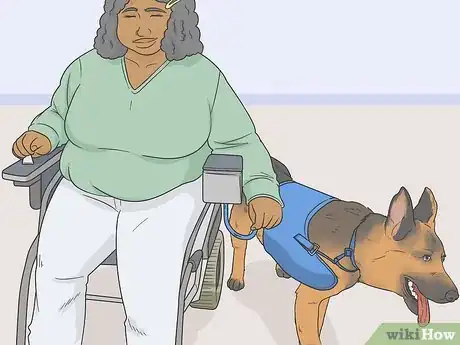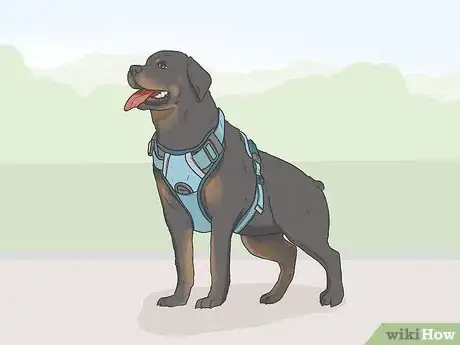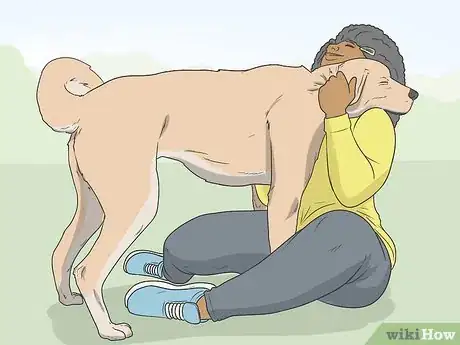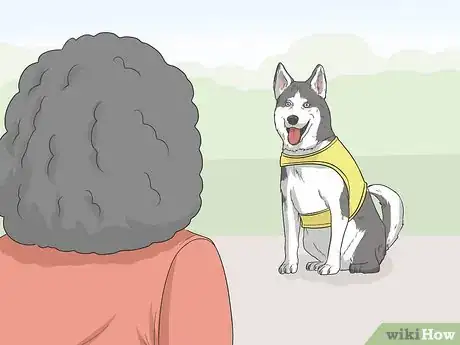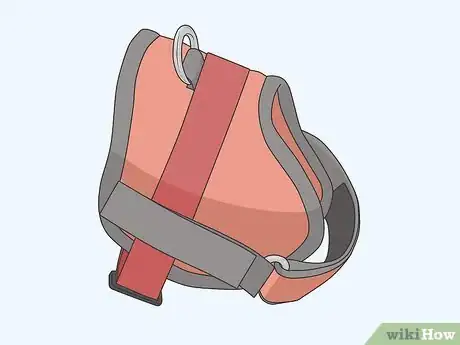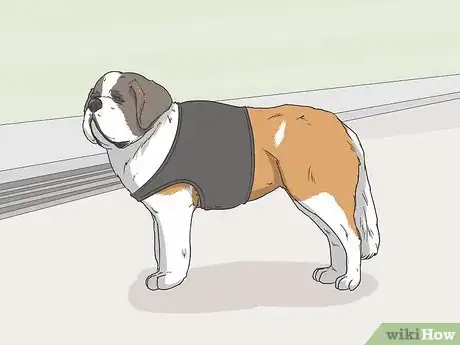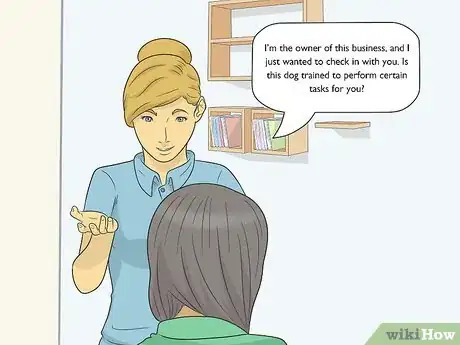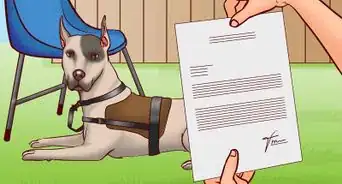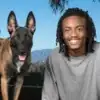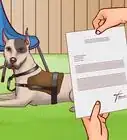This article was co-authored by Indigo Will and by wikiHow staff writer, Janice Tieperman. Indigo Will is a Canine Expert, Trainer, and Founder and Owner of K9-INDIGO® Holistic Dog Training LLC™, a dog training service in Los Angeles, California. Indigo specializes in understanding canine temperament and dispositions to allow canines to reach their full potential. He has studied various methods of training and philosophies to develop a unique, innovative, and result-driven method for canine behavior training.
This article has been viewed 10,425 times.
Service dogs help countless people go about their daily lives safely. Since these are working animals, you can’t pet or play with these dogs while they’re on the job. If you’d like to try identifying a service dog, first go over the different tasks that these animals perform on a regular basis. Next, try observing the dog and taking note of its appearance and temperament. If you’d like any extra clarification, tactfully ask the owner or handler if the dog in question is trained to do certain tasks. With the proper precautions, you can safely and respectfully co-exist with these specially trained pups!
Steps
Recognizing Service Dog Traits
-
1Look for dogs performing physical tasks for their handlers. When you see a service dog on the street, don’t automatically assume that it’s a seeing eye dog. Instead, note that service dogs are trained to assist the hearing impaired, people prone to seizures, individuals with psychiatric conditions, and people with autism. Look for dogs that are guiding, alerting, and guarding their owner; depending on the type of service dog, these behaviors can serve different purposes.[1]
- Sensory signal dogs help individuals with autism notice when they’re making a repetitive movement.
- Seizure response dogs pay attention to warning signs of a possible incident, and protect their owner when a seizure occurs.
- Psychiatric service dogs help people cope with a variety of mental illnesses, such as PTSD. These dogs can turn on lights, and work to corral their disoriented owners away from dangerous situations.
- All service dogs are protected under national legislation, which forbids citizens from directly asking about the dog’s job.[2]
-
2Keep in mind that not all handlers look disabled at a glance. While service dogs assist with serious and sometimes life-threatening conditions, note that these conditions might related to sensory, intellectual, and psychiatric issues. For seizure-prone individuals, acknowledge that service dogs provide life-saving assistance during an incident. For people with psychiatric and intellectual disabilities, note that service dogs help these people to lead high-functioning lives.[3]
- If the service animal isn’t a seeing eye dog, then there’s a good chance it’s helping with a different, less obvious condition.
Advertisement -
3Classify psychiatric service dogs separately from Emotional Support Animals (ESAs). Note that ESAs solely provide comfort, while psychiatric service dogs are physically trained to perform different tasks for their owners. While these animals can be difficult to distinguish, identify ESAs through excessive, typical, dog-like behaviors. If a dog seems especially well-trained, quiet, and attentive, you can safely assume that it’s likely a service dog.[4]
- Since ESAs aren’t trained service dogs, their jobs and identities aren’t protected under national disability legislation.
-
4Note that ESAs, courthouse dogs, and therapy dogs aren’t service animals. Like service dogs, ESAs assist 1 person; however, note that ESAs only provide emotional support and comfort, and are not trained to do physical tasks. Additionally, don’t confuse courthouse and therapy dogs as service animals. Instead, note that these animals, like ESAs, only provide emotional comfort to people, and aren’t trained to physically assist with a disability.[5]
- Unlike service animals, courthouse pups, therapy dogs and ESAs can be pet and given affection while they’re working. With this in mind, you should always ask permission before petting a non-service animal.
-
5Avoid identifying service dogs by a nationally issued uniform. Don’t expect service dogs to all wear the same outfit while they’re on the job. Depending on the owner, the dog might not wear any kind of obvious identification that you can recognize on the fly. Instead, remember that outfits and accessories are specific to the dog, and not its specific role as a service animal.[6]
-
6Watch and listen for dogs that are especially quiet and focused. Observe any given dog that you pass on the street, and see if the pup is distracted with sniffing, barking, pulling at the leash, or other stereotypical dog behaviors. If the dog doesn’t seem to be distracted by its surroundings and acts attentive and focused, there’s a good chance that the pup is trained to assist with a certain disability.
- While all service dogs need to be well-trained, not all well-trained dogs are service animals. Pay attention to the context of your surroundings before jumping to any conclusions.
- All service dogs have calm, confident temperaments.
Looking for Visual Characteristics
-
1Check for vests or collars that identify the dog’s purpose. While service dogs don’t have to wear a specially issued uniform, you can still be on the lookout for special ID tags, collars, and harnesses that identify the dog’s role. See if these garments or accessories specify what kind of service the animal provides.
- Don’t use harnesses or accessories as a definite label for a service dog. Many fake service dogs are put into special outfits in an attempt to pass as service animals.
-
2Spot a special cart, harness, or leash that the dog uses. Look for any accessories that the dog seems to be hooked up to. If the dog is providing physical assistance, you might see a metal cart or handle attached to the dog’s back. Additionally, look for any special guiding harnesses that are attached to the dog’s back.
- Visually impaired individuals need to be close to their seeing eye dog to travel around safely. They use special harnesses to help the animal provide effective guidance.
-
3Note that large, muscular dog breeds often assist people with visual disabilities. Try determining the service dog’s breed to figure out what its job is. While a variety of breeds can be trained for different service jobs, note that athletic, active breeds are often paired with visually impaired individuals. If you see a Labrador Retriever, Golden Retriever, or German Shepherd, you can safely assume that the dog is helping a visually impaired person, or an individual with a physical disability.[7]
- Seeing eye dogs need a lot of mobility and strength to safely guide the affected individual through different tasks.
-
4Keep in mind that giant dog breeds help with mobility issues. Look for large, stocky dog breeds, like Saint Bernards, Great Danes, and Bernese Mountain Dogs. If you see a large, bulky dog assisting someone with a physical disability, assume that the animal is providing mobility assistance. You might also see these dogs wearing specialized harnesses to complete their duty.[8]
- Since mobility assistance dogs are helping people get around their home and other public areas, these dogs need to be tall and muscular, but it may vary depending on the individual person.
-
5Assume that a small dog probably isn’t a mobility service animal. Note that many service dogs perform a lot of physical tasks for their owners, like alerting and guarding them from dangerous situations. Since these animals need to be large enough to guide and assist their handlers, you won’t see many tiny dogs acting as service animals in these cases.
- However, note that small dogs can also perform service-related tasks, such as alerting people of distressing situations or noticing arising causes of distress. Some of the smallest service dogs that you may run into can include Toy or Miniature Poodles, which can sniff out changes in blood sugar.[9] Pomeranians are also a breed used for identifying symptoms of asthma, diabetes, and other conditions.[10]
- Smaller dogs can also be used as psychiatric service dogs, depending on which tasks they must perform, such as providing reminders for someone to take their medication each day.[11]
Getting Verbal Confirmation
-
1Ask if the dog is needed to assist with a disability. If you’re a business owner who doesn’t normally permit dogs in your building, ask the owner or handler if the dog is providing assistance for a specific condition. Don’t try to ask any other intrusive questions about the dog’s identity or role, as this is against the law. Whenever you speak with the owner, phrase your questions in a tactful and respectful way.[12]
- For example, try saying something like this: “I’m the manager of this store, and I need to ask if your animal is assisting you in some way.”
- If you’re a civilian, you don’t have any reason to ask about the dog’s purpose in any given area.
-
2Inquire about the tasks the dog is trained to do. If you manage or own a business that isn’t pet-friendly, inquire if the dog is trained to complete certain tasks for the owner. Note that you aren’t legally allowed to interrogate the handler about their service animal, so try and be as tactful as possible. If you’re a customer, you don’t need to get verbal confirmation about the service dog’s identity.[13]
- For instance, try saying something like this: “I’m the owner of this business, and I just wanted to check in with you. Is this dog trained to perform certain tasks for you?”
-
3Don’t ask for paperwork or physical proof that the dog is trained. Whether you’re a business owner or curious citizen, don’t intrude on a person’s privacy by asking for proof that their animal is trained for service. These types of questions are against the law, and are disrespectful to the individual in question. Don’t inquire about the dog’s identity or behavior unless it is biting, growling, or directly interacting with you.[14]
- If a service dog is being actively disruptive in a business or public building, the owner can ask the service animal and their owner to leave.
Expert Interview

Thanks for reading our article! If you'd like to learn more about identifying working dogs, check out our in-depth interview with Indigo Will.
References
- ↑ https://nurse.org/articles/assistance-animals-how-can-you-tell/
- ↑ https://adata.org/faq/how-can-i-tell-if-animal-really-service-animal-and-not-just-pet
- ↑ https://nurse.org/articles/assistance-animals-how-can-you-tell/
- ↑ https://www.akc.org/expert-advice/training/service-dog-training-101/
- ↑ https://www.akc.org/expert-advice/training/service-dog-training-101/
- ↑ https://www.workingservicedog.com/what-is-the-official-color-for-a-service-dog-vest.aspx
- ↑ https://www.akc.org/expert-advice/training/service-dog-training-101/
- ↑ https://www.akc.org/expert-advice/training/service-dog-training-101/
- ↑ https://www.akc.org/expert-advice/training/service-dog-training-101/
- ↑ https://www.akc.org/expert-advice/lifestyle/most-popular-service-dog-breeds/
- ↑ https://www.akc.org/expert-advice/training/service-dog-training-101/
- ↑ https://www.ada.gov/archive/qasrvc.htm
- ↑ https://adata.org/faq/how-can-i-tell-if-animal-really-service-animal-and-not-just-pet
- ↑ https://adata.org/faq/how-can-i-tell-if-animal-really-service-animal-and-not-just-pet
